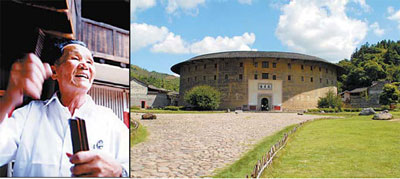The age-old earth buildings look like miniature fortifi ed castles.
It was said that the first foreign visitors to Yongding County, in southwestern Fujian Province, were CIA agents who were spying on some "suspicious Chinese missile bases" in the 1960s.
Dotted among the dark green mountains are densely concentrated blocks of round shaped buildings.
Every year, thousands of tourists from home and abroad travel to Fujian to unlock the secrets of these mysterious buildings. Some call them UFOs from another planet, others describe them as giant mushrooms growing in the mountains.
Actually these odd looking buildings are tulou, or earth buildings, which have been home to generations of local Hakka people for more than 1,000 years. In 2004, these age-old buildings were included on UNESCO's World Cultural Heritage list.
During my recent trip to Fujian, I finally had an opportunity to get a closer look at these renowned buildings.
The history of these earth buildings dates back to the Tang Dynasty (AD 618-907) when Hakka people migrated from central China and settled in the coastal province of Fujian.
Since Hakka people traditionally lived in the mountains, they built these houses to protect themselves against bandits and wild animals.
Yongding has more than 4,360 Hakka earth buildings - each like a miniature fortified castle.
The outer wall of the buildings are either round or rectangular and made of rammed earth, stone and lime. Inside the earthen walls, branches, strips of wood and bamboo chips act as "bones" to reinforce them.
"These buildings are windproof and quakeproof. More surprisingly, they are warm in winter and cool in summer," says my guide Que Xiaofang, a 22-year-old Hakka woman.
"Some people say the builders also used brown sugar to solidify the earth," Que adds. "But I wonder if it's true, as ants would probably have taken over the buildings."
Zhencheng Lou, built in 1912, is a prime example of East-meets-West architecture in Yongding.
Locals call the building complex "the prince of tulou" for its splendid shape and unique interior.
Stepping through the gate of Zhencheng Lou, I felt like I was walking to the bottom of a huge well.
The design is inspired by China's bagua, an eight-sided diagram derived from I Ching (The Book of Changes). The building also features Western architectural style.
The 5,000-sq-m structure is composed of an inside ring, an outside ring and a central hall. The outside ring has four stories - each floor with 48 rooms. The first floor mostly consists of living rooms and a food storeroom; the second floor and above are usually bedrooms.
The outside ring is divided into eight components, with each side forming a courtyard separated by firewalls.
When I took a walk around a courtyard, I saw some farmers laying out their persimmons and corn to dry in the sun. Que told me persimmons were a household flavor in Yongding.
The inside ring has two stories, with 30 rooms. A hall, featuring ancient Greek architectural styles, is reserved for important family affairs, such as weddings, funerals and meetings.
There are two wells - the Wisdom Well and Beauty Well - in the east and west of the hall, symbolizing Yin and Yang in ancient Chinese philosophy. It is said that the water in the Wisdom Well is warmer and can make drinkers wise, while the water of Beauty Well is cool and can make drinkers beautiful.
Now Zhencheng Lou is home to 14 families surnamed Lin. Lin Rigeng, 56, is one of the residents. Holding his grandson in his arms and sitting near his souvenir shop, Lin sipped a cup of oolong tea and shared the stories of his family and the building.
His father, Lin Honghui, who graduated from Waseda University in Japan, together with other family members, spent five years designing and building Zhencheng Lou.
Born and raised in Zhencheng Lou, Lin Rigeng has a deep understanding of the traditional culture of Hakka people.
"The Hakka people have lived as farmers for generations. They are hardworking, independent and know the importance of education," Lin says.
The Hakka earth buildings, Lin says, are like "a book without end", "the symbol of a history of the Hakka people's pursuit of a better life".
Lin is the youngest child in a family of 10 and most of his brothers and sisters have graduated from top universities. Some have settled down in Singapore. Lin is proud of his youngest son who has just graduated from university and found a job in Hong Kong.
In 1991, Hakka earth buildings were opened to tourists. Lin then started as the first tour guide in Yongding, and over the past decade he has worked for experts and tourists from over 20 countries.
The influx of tourists has also brought changes to the lives of locals. Lin and other clan members now run businesses, such as souvenir shops, restaurants and guesthouses. The local government also provides funding, helping them preserve the old buildings.
Now Lin says he is looking for tour guides who can speak different foreign languages to meet the demand of tourists from all over the world.
Left: A local woman shares with visitors the story of Hakka earth buildings.
Right: Zhencheng Lou is one of the best preserved tulou in Yongding, Fujian Province. File photos
(China Daily January 10,2008)



